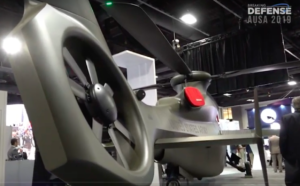AUSA: Bell is used to having the fastest entry in military aircraft competitions. But in the race to build the Army’s new high-speed scout, the Future Attack Reconnaissance Aircraft, Bell has decided to take the (relatively) slow and steady approach instead. Just listen to Bell exec Frank Lazzara in his video interview with our Rick Whittle (above).
The first substantive statement Lazarra makes? “What you see before you is an aircraft … providing a low-risk path for the Army to meet the timeline, the schedule, and the cost objectives.”
[Click here for our in-depth analysis of the Bell 360’s design]

Their Bell 360 Invictus design doesn’t claim 200-knot-plus speeds (230-plus mph) like some competitors, although by beating 180 knots (207 mph) it’s still fast enough for the Army’s requirements, and faster than almost any conventional helicopter. But Bell sees the 360’s main selling point as low cost and high reliability.
Will this pan out? Well, to get such high speed out of a conventional helicopter design, Bell had to add wings for extra lift, ruthlessly streamline the airframe, and pack in a supplementary power unit to boost the Army-prescribed GE T901 engine. That is some ingenious engineering, but it’s complex enough to be challenging to build on time and schedule.

The questions that warfighters ask the most are now answered with data analytics
CDAO’s Advana data analytics platform is ingesting data from about 500 DoD business systems.
Read the rest of our series of stories on each of the five Future Attack Reconnaissance Aircraft contenders: